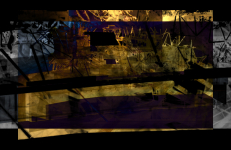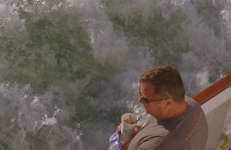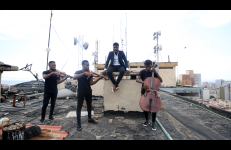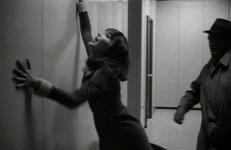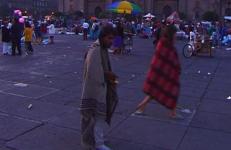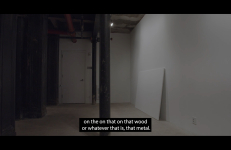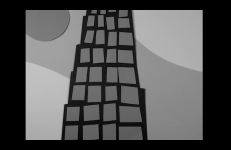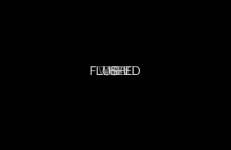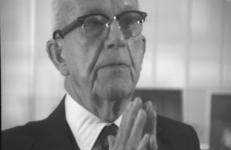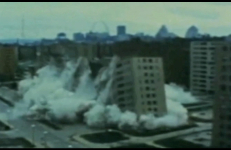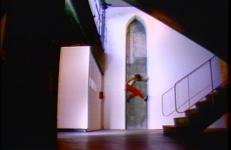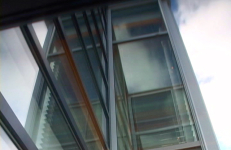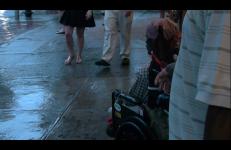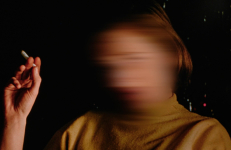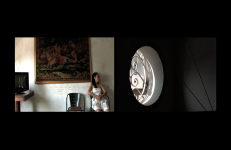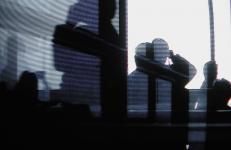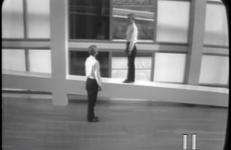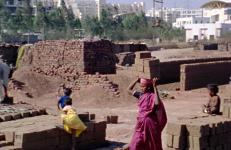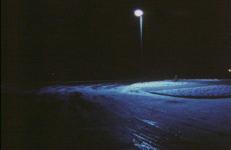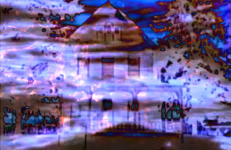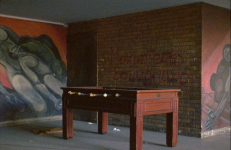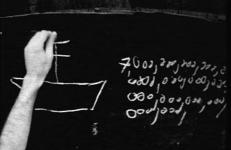A Kafkian vision of the New World. The arrival of Karl Rossman to the contemporary Babylon under the spell of the paranoid avant-garde. Kinetic coexistence of the archaic forms in dissolution.
Architecture
The first of the series includes:
What Does Away Mean? by Jem Cohen advertises the need to recycle through reconsideration of landfills and garbage disposal.
Pro-Choice is Pro-Life by Jane Pratt makes its point with the simple logic that every child should be cared for and wanted.
Historic Preservation by Jim McKay counsels for the preservation of historic buildings endangered by urban decay.
[A] postcard-sized [film that]…manage[s] to implicate the audience’s ethical imagination…Distant Shores models a necessary imaginative leap simply by juxtaposing footage of a Chicago River cruise with testimony of a migrant’s harrowing voyage at sea. A three-minute film edited in camera; it nevertheless offers several ways of thinking about displacement.
–– Max Goldberg, KQED Arts
Dó is an audio/visual synthesis between a dual screen video installation and a sound installation which was developed in collaboration with the Portuguese-Cape Verdean rapper/music composer Chullage. The video depicts a dancer gazing at the city from the top of the “Book building” in Luanda. This building which resembles a book, is emblematic of iconic modernist architecture from the 1960s. The scenario is interlaced with sound and footage of a string orchestra performing a discontinuous piece in multiple locations such as ruined spaces.
El Livahpla (Alphaville spelled backwards) is about the ways in which we "normals" are encapsulated in architecture and technology. Through the lens of Alphaville, we see into a past that exists in the present, while showing a future that looks old. It is a waking dream in which the objects of design that surround us fail to provide the answers or the escape that we seek.
This title has been remade as Une Ville de l'Avenir.
El Zócalo is an observational portrait of Mexico City’s central Plaza de la Constitutión during one day in August. Soldiers, Aztec dancers, clowns, food vendors, protestors, rain, dogs, tourists, kites, balloons, and dignitaries all meet in the public space of the Zócalo. This documentary presents daily life in one of the largest and most vibrant urban centers in the world, but it begins with a dream of history and ends with a dream of the space full of people for a Zapatista rally.
El Zócalo is an observational portrait of Mexico City’s central Plaza de la Constitutión during one day in August. Soldiers, Aztec dancers, clowns, food vendors, protestors, rain, dogs, tourists, kites, balloons, and dignitaries all meet in the public space of the Zócalo. This documentary presents daily life in one of the largest and most vibrant urban centers in the world, but it begins with a dream of history and ends with a dream of the space full of people for a Zapatista rally.
Framing the solo exhibition Prophetic Memory, this video remediates images of the NYC nonprofit art gallery, Artists Space, with the filmmaker’s grandmother's descriptions of how she would use her interior design skills to design their exhibition. Because she couldn’t travel there because of disability and the risks posed by the Covid-19 pandemic (even as this show occurred during the first wave of NYC art spaces “returning to normal"), she relies on the images she’s watching and describing to visualize her ideas.
Failing Up describes career advancement despite bad decisions, bankruptcies, and intellectual mediocrity. In this short film, the Manhattan real estate holdings of the King of Failing Up are catalogued and synced to a soundtrack that suggests how it feels to be one of his subjects.
Whip pans, zooms, lens twists, and bursts of stop-frame animation transform eight minutes of borrowed audio from Home Alone 2 (a film that features a cameo of the current US President) into a political work of slapstique concrete.
A short anecdote created for an exhibition in commemoration of the events of September 11.
Buckminster Fuller (1895-1983) was both a pioneer architect of the modern era and a global theorist. Fuller developed a system of geometry that he called “Energetic-Synergetic geometry,” the most famous example of which is the geodesic dome. His many designs for automobiles and living spaces were applications of a wider theory.
Futures for Failures is a double narrative of failure: architectural and social. Archival footage from a demolition of the Pruitt-Igoe building in St. Louis manifests as the materialization of modernity’s failure. Meanwhile, an intimate voiceover recounts a moment of laughter erupting during a stranger’s funeral, staging anachronous conversation between the disappeared and the disappearing.
A Yosemite gargoyle climbs two gothic arches.
This title is also available on Sympathetic Vibrations: The Videoworks of Paul Kos.
Glass House examines the creative process of a modern architect who builds a house made of glass and concrete for his family.
There is no better place to meet people than in the temporary community which gathers under a scant awning on a New York street in a downpour.
"Superimposing the stories of two women—the filmmaker’s late grandmother and the amateur filmmaker Joan Thurber Baldwin—Home When You Return explores the psychogeographies of mourning through a variety of modes, from documentary to melodrama. Emptied and put up for sale following its matriarch’s passing, the family home becomes the site of a winding tour through polymorphic representations of the past in media and memory." - NYFF Currents
Hotel Globo critically examines the changing urban surface of Luanda through video, photographic and performative incursions into the interior landscapes of the 1950s Hotel Globo in Luanda, Angola. The modernist hotel is still functioning in Luanda’s downtown, whose architectural heritage has been increasingly replaced with gentrified high-rise luxury buildings.
Hub proposes that the idea of home is today perhaps better expressed as a sense of being between places. Within the dalectical interplay between global processes and local environments, Hub suggests that displacement and mobility itself might be thought of as a new way of belonging. Hub uses the transitory space of the airport—defined by its arrivals and departures—to introduce the notion of disappearance to articulate new ideas on belonging and identity.
In this video, MICA-TV interprets the dark spaces of architect Peter Eisenman’s Wexner Center for the Visual Arts at Ohio State University through a fractured narrative of psychological perspectives. Eisenman’s pastiche of historical and contemporary architectural motifs, a characteristic of the postmodern style he pioneered, finds a parallel in this tale of haunted castles and a disappearing golem, told through a correspondence back through time.
In this video, MICA-TV interprets the dark spaces of architect Peter Eisenman’s Wexner Center for the Visual Arts at Ohio State University through a fractured narrative of psychological perspectives. Eisenman’s pastiche of historical and contemporary architectural motifs, a characteristic of the postmodern style he pioneered, finds a parallel in this tale of haunted castles and a disappearing golem, told through a correspondence back through time.
"Bricks are the resonating fundamentals of society. Bricks are layers of clay that sound like records, just simply too thick. Like records they appear in series, but every brick is slightly different – not just another brick in the wall. Bricks create spaces, organize social relations and store knowledge on social structures. They resonate in a way that tells us if they are good enough or not. Bricks form the fundamental sound of our societies, but we haven't learned to listen to them.
An uncompromising look at the ways privacy, safety, convenience and surveillance determine our environment. Shot entirely at night, the film confronts the hermetic nature of white-collar communities, dissecting the fear behind contemporary suburban design. An isolation-based fear (protect us from people not like us). A fear of irregularity (eat at McDonalds, you know what to expect). A fear of thought (turn on the television). A fear of self (don’t stop moving).
Part of paraconsistent sequence series and the hauntology series.
Born out of an "objective hazard" (a 16mm roll where two different subjects were imprinted by mistake), jeny303 is a composite work intertwining two portraits. On the one hand there is jeny, the feminine alter ego of a transgender millennial dealing with a heroine addiction. On the other hand there is the 303 building, an iconic modernist architecture in a public university in Bogota (Colombia). The images of the body and the edifice interlace and depict jeny303, a character on the threshold of a transformation to come.
In his New York City landscape, Cohen finds inspiration in disturbance. Looking to life for rhythm and to architecture for state of mind, he locates simple mysteries. Just Hold Still is comprised of an interconnected series of short works and collaborations that explore the gray area between documentary, narrative, and experimental genres.




